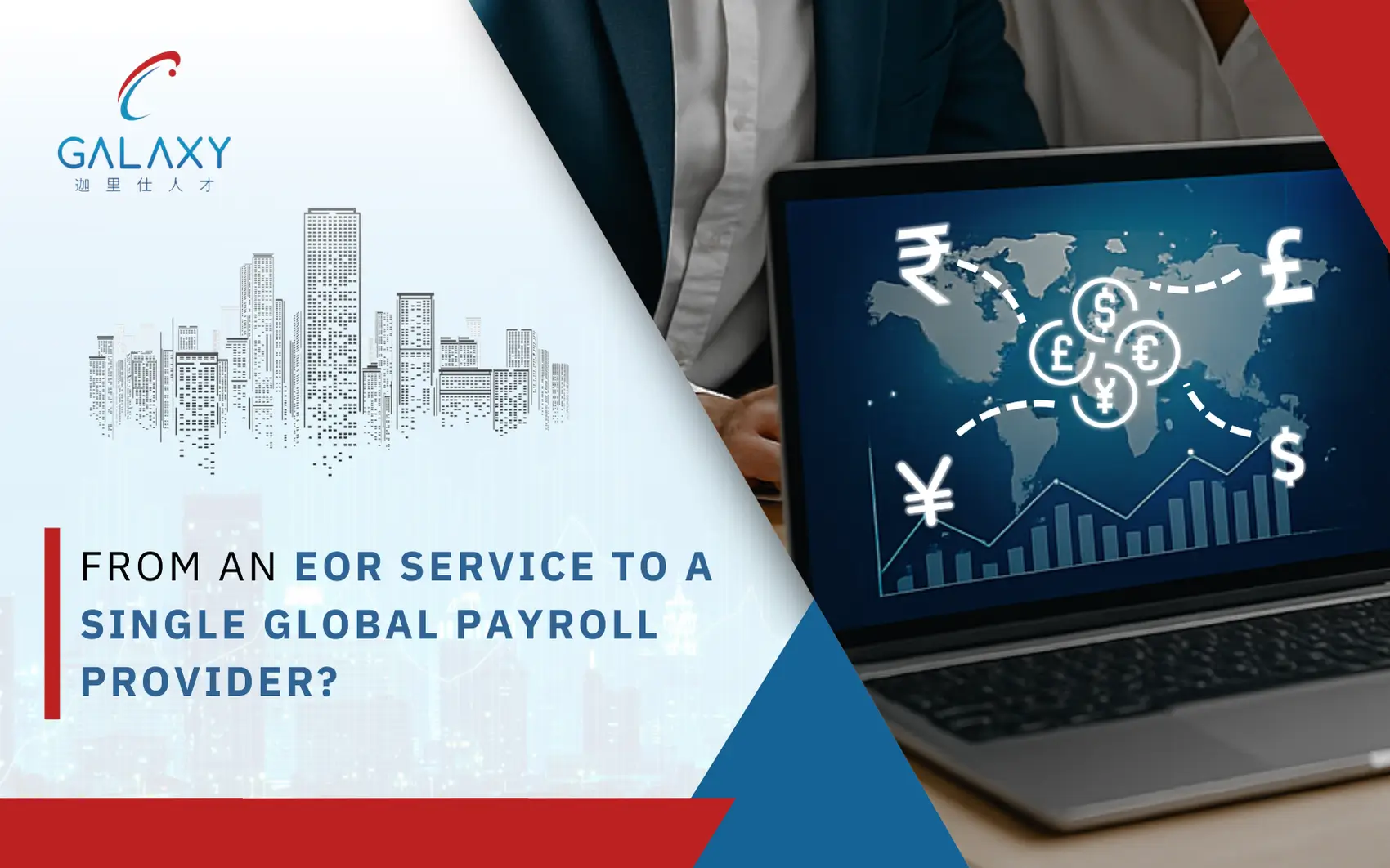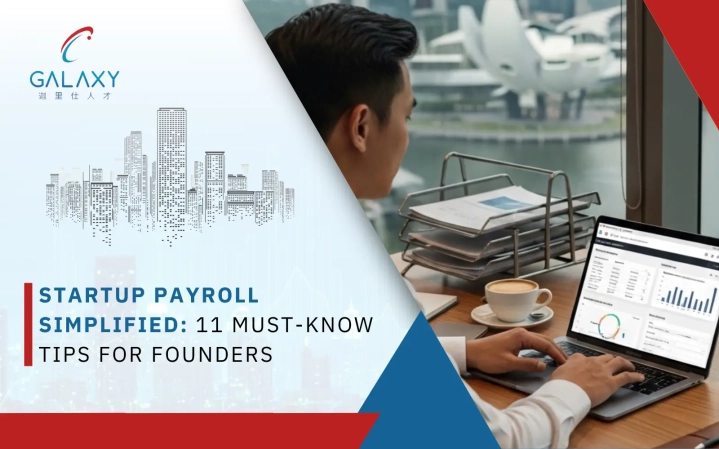From an EOR Service to a Single Global Payroll Provider?

As companies expand globally, payroll solutions must also evolve to support sophisticated operations. Employers of Record (EORs) offer a practical solution for rapid market access, eliminating the need to establish local legal structures, simplifying hiring, reducing compliance requirements, and streamlining operations with minimal infrastructure.
However, as teams become more geographically dispersed, the EOR model can become restrictive. Each new hire incurs additional costs, reporting varies by country, and managing multiple suppliers can result in siloed processes and reduced visibility into compliance.
The transition to a global payroll provider provides a centralised and integrated approach. The transition gives more control, standardised reporting, and improved compliance, thereby aligning payroll management with more organisational objectives and long-term growth strategies.
This blog explores the distinctions between EORs and global payroll providers and highlights the advantages of payroll consolidation.
Table Of Content
- What’s the Difference Between an EOR and a Global Payroll Provider?
- When Is an EOR the Right Choice for Global Hiring?
- What Can a Global Payroll Provider Offer?
- How to Know When It’s Time to Move Beyond an EOR?
- Benefits of Using a Global Payroll System Across Countries
- 6-Point Checklist Before Switching from an EOR to Global Payroll
- Conclusion
- Frequently Asked Questions
What’s the Difference Between an EOR and a Global Payroll Provider?
When hiring across borders, companies often choose between two models:
EOR or Global Payroll Provider. Both offer support for managing international teams, but they solve different challenges. An EOR steps in as the legal employer on behalf of a business. It handles everything from employment contracts and payroll to local compliance and statutory benefits. This makes it easier to hire in new markets without setting up a regional entity. It’s a practical option for companies looking to test new regions or hire just a few employees in unfamiliar jurisdictions.
A Global Payroll Provider On the other hand, supports businesses that already have entities in place. They help streamline payroll processing across multiple countries by managing calculations, deductions, local filings, and employee payments, while also offering consolidated reporting. The business remains with the legal employer, but the payroll burden is centralised and simplified.
Here’s a quick comparison:
| Aspect | Employer of Record (EOR) | Global Payroll Provider |
|---|---|---|
| Legal Employer | The EOR becomes the legal employer and takes on local employment responsibilities. | The company remains the legal employer and oversees employment obligations directly. |
| Local Entity Requirement | No local entity is needed; the EOR covers this on behalf of the company. | A local entity must be established in each country where employees are hired. |
| Ideal Use Case | Helpful in entering new markets, short-term projects, or hiring a small number of employees. | Better suited for businesses with a long-term presence and larger teams in multiple regions. |
| Payroll Management | Fully managed by the EOR, including payslips, tax filings, and employee payments. | Managed by the company with support from the provider for calculations and compliance. |
| Compliance Handling | The EOR takes care of most legal and regulatory responsibilities. | Compliance is shared, and the company must stay aligned with local regulations. |
When is an EOR the Right Choice for Global Hiring?
An EOR serves as a strategic solution for companies expanding internationally without setting up legal entities in each country. The following situations highlight when partnering with an EOR can be the most effective approach to global hiring:
1. Entering a new international market
For organisations exploring new markets, establishing a legal presence can delay go-to-market timelines. An EOR enables quick hiring of local talent while maintaining full compliance with local employment laws, making it ideal for pilot programs or market testing.
2. Avoiding the Cost and Complexity of Entity Setup
Setting up a legal entity in a new country often involves considerable time, cost, and an in-depth understanding of local rules. For companies seeking to hire internationally without making a long-term investment upfront, an EOR provides a practical alternative. It takes care of employment contracts, payroll, taxes, and benefits on the company’s behalf.
3. Supporting Small Teams in Multiple Countries
When building distributed teams with only one or two employees in each location, entity creation becomes inefficient. An EOR offers a practical, centralised solution for managing employment across several jurisdictions, reducing both administrative and compliance overhead.
4. Hiring for Short-Term or Project-Based Roles
For short-term staffing requirements, like seasonal employees, consultants, or project specialists, EORs offer versatile support. They handle onboarding, hire-to-retire, and offboarding in accordance with local laws, enabling companies to scale teams up or down to meet the project’s changing requirements.
5. Navigating Periods of Organisational Change
During mergers, acquisitions, or internal restructures, maintaining continuity in workforce management can be challenging. EORs can provide stable employment arrangements during transitions, ensuring that teams remain operational while legal structures are still being finalised.
6. Reducing Risk in Employment Compliance
Global hiring requires adherence to country-specific laws regarding wages, benefits, taxes, and social contributions. An EOR takes on the legal responsibility of employing staff, helping organisations remain compliant with local regulations while streamlining HR and finance operations.
An EOR is particularly effective for organisations seeking speed, flexibility, and compliance in global hiring. It acts as a bridge to new markets and ensures legal peace of mind, whether for short-term projects or the early stages of international expansion.
What can a Global Payroll Provider Offer?
Managing payroll becomes increasingly complex as businesses expand into new markets. A global payroll provider can simplify the process by offering local expertise, ensuring compliance, and delivering scalable systems that support international growth.
Understanding Local Rules
1. Stays up-to-date with changing tax laws, labour regulations, and reporting standards in each country.
2. Ensures payslips, deductions, and filings are done correctly in line with local legislation.
3. Helps avoid fines and compliance risks by handling statutory requirements accurately.
A Single, Centralised System
1. Combines payroll processes across countries into one streamlined platform.
2. Offers better visibility and control over payroll operations in different regions.
3. Reduces the need to coordinate with multiple local vendors or systems.
Hassle-Free Payments in Local Currencies
1. Supports on-time salary disbursement in multiple currencies.
2. Manages currency conversions, local banking rules, and payment timelines.
3. Minimises errors in cross-border payments and ensures a reliable employee experience.
Room to Grow
1. Scales easily as the business enters new markets or hires across regions.
2. Reduces the need for internal payroll expansion or new country-specific processes.
3. Allows companies to focus on growth without worrying about backend payroll operations.
Keeping Data Safe
1. Uses secure platforms that follow global data protection laws like GDPR.
2. Safeguards sensitive employee information with encryption and access controls.
3. Reduces the risk of data breaches or non-compliance in global jurisdictions.
Managing More Than Just Payroll
1. Offers additional services such as statutory benefits administration, social insurance management, and leave tracking.
2. Helps standardise HR practices across different countries.
3. Reduces administrative load on internal teams while improving employee satisfaction.
How to Know When It’s Time to Move
Beyond an EOR?
Working with an EOR can be an innovative and flexible way to hire internationally, especially when entering new markets or managing short-term projects. But as operations grow, there may come a time when a more permanent setup makes sense.
1. Team Building:
Expansion of local teams may be less feasible for EORs; an integrated legal entity provides complete control over HR activities.
2. Long-Term Strategy:
Creating a legal entity involves commitment and renders long-term regional development feasible.
3. Operational Integration:
Direct hiring facilitates better integration with in-house teams, policies, and workflows.
4. Cost Savings:
Scaling up quickly under an EOR may be costly; a local organisation can be more economical.
5. Regulatory Compliance:
Specific industries or sectors require a legal entity to fulfil licensing, contractual, or regulatory requirements.
Benefits of Using a Global Payroll System Across Countries
Managing payroll across multiple jurisdictions can quickly become complex. Implementing a single global payroll system creates a centralised and consistent approach. It helps businesses stay compliant, streamline operations, and support international growth with confidence.
Brings Consistency to Payroll Operations
1. Ensures uniform payroll schedules, formats, and documentation across regions
2. Minimises the risk of payment delays and calculation discrepancies
3. Supports a consistent employee experience, regardless of location
Offers Better Visibility and Control
1. Provides a centralised view of payroll data across all operating countries
2. Facilitates budget planning, workforce tracking, and risk management
3. Supports leadership with accurate, real-time financial insights
Simplifies Compliance with Local Laws
1. Tracks changes in tax legislation, labour codes, and statutory contributions
2. Reduces exposure to non-compliance penalties and legal complications
3. Makes audit preparation and statutory reporting more efficient
Streamlines Daily Operations
1. Decreases reliance on manual processes and fragmented systems
2. Reduces administrative load for HR, finance, and payroll teams
3. Enhances process efficiency through automation and system integration
Scales with Business Growth
1. Supports onboarding in new markets without needing separate systems
2. Enables faster geographic expansion while maintaining payroll integrity
3. Consolidates provider management through a single global platform
6-Point Checklist Before Switching from an EOR to Global Payroll
Transitioning from an EOR (Employer of Record) to a global payroll provider represents a transition from short-term market entry strategies to repeatable, cross-border operations. Upfront assessment of the key areas guarantees compliance, operational efficiency, and long-term value.
Here’s a 6-point checklist to guide the decision:
| Checklist Point | Key Actions |
|---|---|
| Readiness of the Local Entity | ✅ Ensure the business is officially registered in each operating country. ✅ Set up local bank accounts, tax registrations, and employment systems. ✅ Confirm the entity can independently manage payroll, hiring, and compliance. |
| Understanding of Local Payroll Requirements | ✅ Learn local tax brackets, wage laws, and statutory benefits. ✅ Align payroll cycles with local deadlines to avoid penalties. ✅ Verify worker classifications to prevent legal issues. |
| Suitability of Internal Systems | ✅ Evaluate if HR and finance tools support multi-country payroll. ✅ Check adaptability to varied pay structures and compliance rules. ✅ Ensure adherence to data privacy regulations in all locations. |
| Compliance and Documentation Requirements | ✅ Implement internal compliance checks for audits and inspections. ✅ Keep contracts, payslips, and payroll records secure and organised. ✅ Understand local reporting formats and submission timelines. |
| Selection of a Global Payroll Provider | ✅ Choose a provider with expertise in target markets. ✅ Ensure capability for salary processing, tax filings, and compliance. ✅ Opt for providers offering scalable solutions and local knowledge. |
| Internal Operational Readiness | ✅ Define roles and responsibilities across HR, finance, and legal. ✅ Train teams on country-specific payroll practices. ✅ Create a streamlined process for payroll queries and issue resolution. |
conclusion
Many businesses find EOR services to be a helpful starting point when entering new markets. But as operations grow and become more complex, there is often a need for greater visibility, consistency and control. In such cases, a more integrated payroll approach becomes essential.
Transitioning to a single global payroll provider isn’t just about simplifying systems. It’s about building a foundation that can scale with the business, support compliance across jurisdictions, and bring payroll, finance, and HR onto the same page. It enables teams to transition from reactive management to proactive planning, all while maintaining focus on local requirements.
Galaxy Group works closely with businesses navigating this shift. With regional expertise and scalable infrastructure, the focus is on helping organisations streamline operations, reduce complexity, and plan confidently for what’s ahead.
As global workforces evolve, so should the way payroll is managed. Choosing the proper setup is a strategic decision rather than a technical one.
Ready to streamline your global payroll?
Talk to our team and find the proper setup for your growing business.
FAQ’S
What’s the difference between an EOR and a global payroll provider?
An EOR becomes the legal employer for your overseas team and handles everything from contracts to compliance. A global payroll provider supports your in-house HR team by managing payroll across multiple countries once you’ve set up your legal entity.
When is the right time to switch from an EOR to a global payroll provider?
If your team is growing, you’ve set up a local entity, or you want more control over compliance and reporting, it’s likely time to move to a global payroll model. It’s a natural step for companies ready to scale sustainably.
Can a global payroll provider handle minimum wage changes in different countries?
Yes. Most global payroll platforms stay updated with local labour laws and adjust payroll calculations automatically, so you remain compliant without tracking every change yourself.
Is switching to a global payroll provider more cost-effective than staying with an EOR?
Often, yes. EORs work well for early-stage expansion, but they can become expensive as your team grows. A global payroll setup typically reduces costs and gives you more control over operations.
Can I use both an EOR and a global payroll provider at the same time?
Yes. Many companies take a hybrid approach by using EORs in countries where they don’t yet have an entity and a global payroll where they do. This allows for flexible and phased expansion.




